« July 2012 |
Main
| September 2012 »
 August 30, 2012 | Vamps. Expanding the Diatonic triads
August 30, 2012 | Vamps. Expanding the Diatonic triads
Last week we introduced the first in our series on Vamp, taking static chords that might be "vanilla" all by themselves, stumming "G. G. G. G. G. G, etc." and supercharging the pattern with chords out of the same scale. The idea is to add the condiments that don't betray the tonal center, the "G-ness" of the measures, but freshen the accompaniment. We did it with simple three-note chords, major triads, including three different variations commonly called "inversions." If you haven't read this already, we encourage you to double back and soak it in: Vamps. Creating energy with Diatonic triads.
We briefly mentioned the notion of transposing these basic patterns to other keys, and this is important enough to emphasize and belabor further. These three simple inversions become your oyster if you can internalize the pattern and start moving them up and down the fretboard, even across the strings. (With 3-note chords, you can do that!)
This was where we left off, moving the 2nd inversion D into a more comfortable fret region. Don't worry about the inversion label; just learn the relationships:
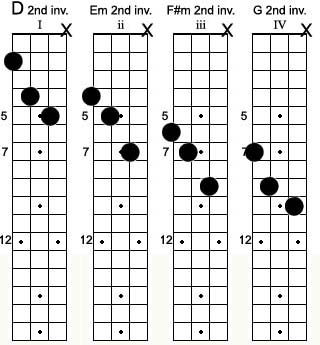
Remember to play around with it some. Strum the chords a couple times with some variation:
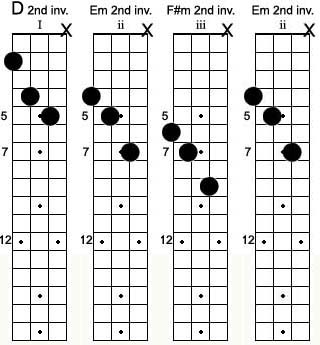
Feel free to mix it up:
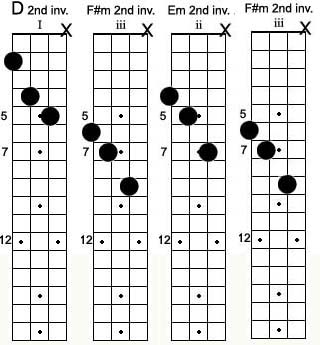
Using the same set of inversions in the same key, we want to add a little magic, with these chord that are only a 1/2 step, one fret away:
 . . 
Add the Fminor chord into the pattern. Mechanically, it's an extremely easy thing to do, but it has a mature aesthetic effect:
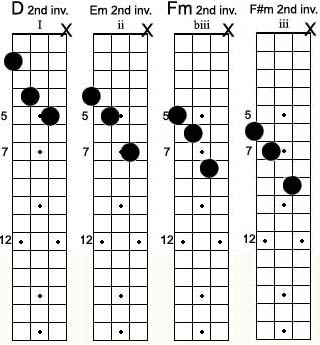
And the the C# major chord, play the following pattern several times. Note that with this chord played on the offbeat, it doesn't throw the tonal center off, rather adds a nice little spice to the progression:
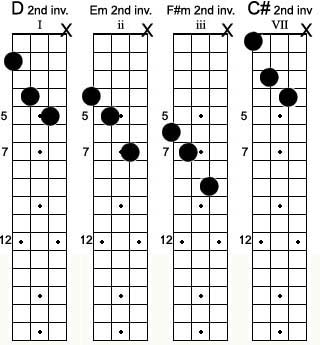
You can do the same with the next inversion, adding the same slick ascending one-fret trick.
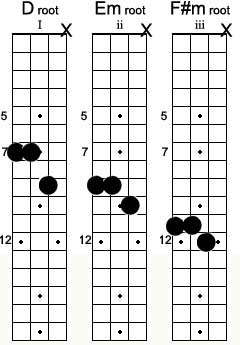
Insert these two chords at will. Like the cooks say, season to taste
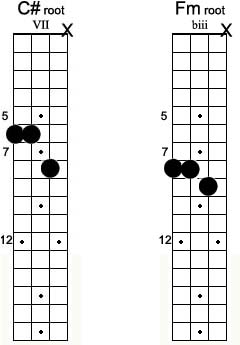
Again, simple in mechanics, with the insertion of these into the pattern, you're adding additional energy without harmonic distraction.
Play around with these and see if you can do the same with the third (1st inversion) set of blocks from last week.
Further
Vamps. Creating energy with Diatonic triads
Fitting in with triads
5-string chording. A different way of thinking...
Static Changes: V7 chords
More Three-note chords to supercharge your comping
Posted by Ted at 10:11 AM
 August 23, 2012 | Vamps. Creating energy with Diatonic triads.
August 23, 2012 | Vamps. Creating energy with Diatonic triads.
We've done several articles on 3-note chords, particularly 7th chords, including Major, Minor, and Dominant 7ths. It's long been our contention you don't need to worry about hitting all four pair of strings to get the most of your chords. Sometimes, not worrying about that 4th voice frees you up to move around the fretboard, plus liberate the pinky for all kinds of delicious mischief when you just voice comping chords on the thickest three strings.
But how about we go back a step further? There's nothing that says you always have to do 7ths or even extensions beyond that. Once in a while, a simple triad is enough, especially when you employ the tricks within this lesson. Triads (sans the 7th) based on the diatonic scale give you the same sense of motion and energy, without betraying the tonal center. Think of the song "Lean on Me." It's all a sequence of diatonic chords. I, I, ii, iii, IV... IV, iii, ii I, etc.
Lets start with simple triads based on the first three notes of an A scale:
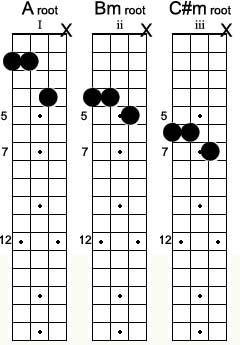
If you were playing a song with multiple measures of A chords, you could fill in with these, move up and down, back and forth:
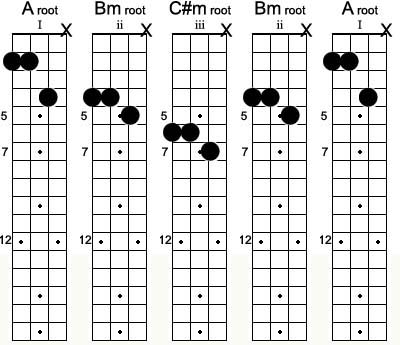
Many pit orchestra scores include simple instructions written: "Vamp." These will be measures where the conductor can adjust the length of the music to the dialogue, giving the actors more breathing room to articulate the dialogue. If a pianist or rhythm player were to just thump, straight A chords, the orchestration would be pretty dull. Chances are chords would be spiced up similarly and in a way that doesn't lose the sense of "A-ness" so that the singers and orchestra could return to the music. Of course, you can do the same in jazz comping.
Let's open it further by adding the IV chord. Move it up and down, mixing different chords in sequence:
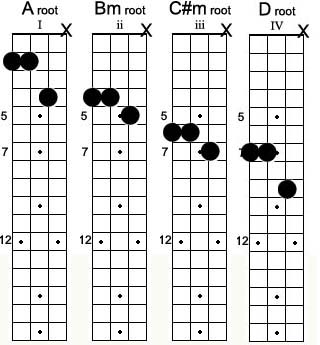
Next, let's broaden this by using a different inversion of the A chord . We spelled the earlier ones based on the root, aptly named "Root" position. Let's spell the chords with the 3rd (C#) as the lowest note (also known as 1st inversion, fellow theory geeks):
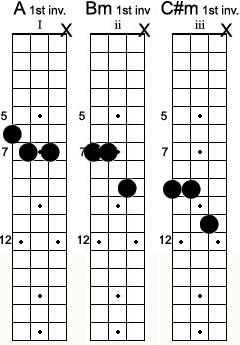
Add the IV chord, too:
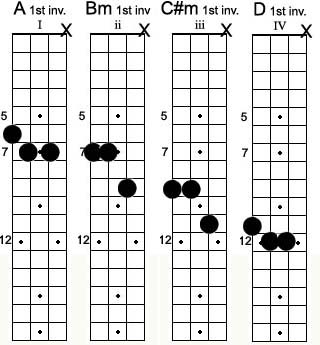
We still have one incarnation of the triad left to put as the lowest (bass) note, and we'll arbitrarily call this the 2nd inversion:
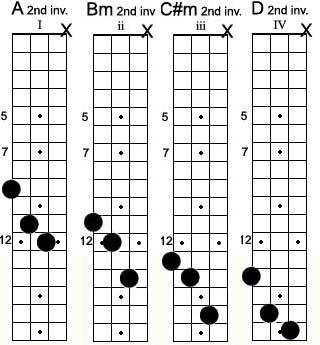
It gets up there in the fretboard stratosphere, but it's a good solid set of blocks for you to learn and internalize! Have fun moving these around. If this doesn't work on your mandolin as well, transpose the latter set to the key of D. We can do that, you know:

Note, you can run the board with this, literally. You can transpose the A root inversions to the key of D, and the 1st inversion as well. Step out and move these blocks into other keys and really have some fun. You'll see these repeat all over the place, and if you can internalize these 3-note blocks, you can open yourself up to untold possibilities!
1.) Chord melody. You have a free voice in the E string for voicing a melody
2.) Chord extension. Add a Maj7, Maj6, Add 9, etc
3.) Vamping texture. Make your chord comping interesting by inserting the variations into your background accompaniment.
Start practicing these in large and small doses. It will pay you back exponentially!
Further
Fitting in with triads
5-string chording. A different way of thinking...
Static Changes: V7 chords
More Three-note chords to supercharge your comping
Posted by Ted at 5:38 AM
 August 16, 2012 | Chip Booth on music over time
August 16, 2012 | Chip Booth on music over time
We've enjoyed the prose and photography of Idaho musician, Chip Booth. He's recently started up a blog based on his nearly three decades of playing experiences and evolving philosophies. His most recent entry resonated with several articles we've posted based on playing with perfection, performing best in "the zone." With his permission, we've excerpted this below. Hopefully we'll get him to do some guest articles for us, as well.
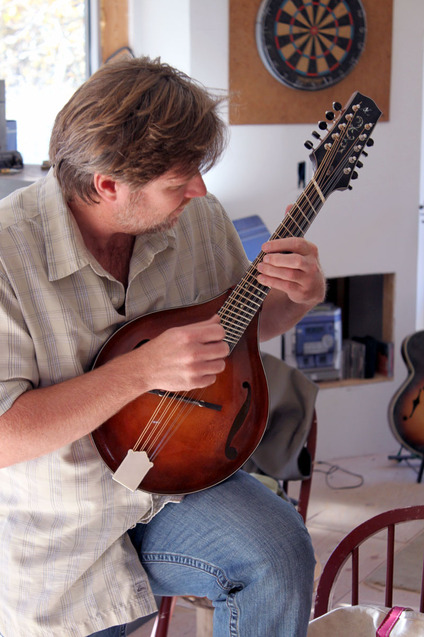
Chip Booth with a Lawrence Smart 10-string mandolin
"As we begin to learn songs notes are grouped in combinations we refer to as phrases. Musical phrases are much like a written or spoken sentence or sentence fragment: a combination of notes, as opposed to words, whose meaning becomes important in the way they are grouped together. Phrases occur over the course of one more measures. At this point the goal we have in mind is to completete our phrase. The completion of that goal is now a second or more into the future. As you play you may see this goal in sight, and begin to hear your notes not as indiviuals but as a stream of sounds that all lead to a single point, creating a coherent musical thought. This is when our performance has the opportunity to become more nuanced. We can now shape the phrase to add feeling, playing it quietly, or loudly, perhaps crescendoing to a final note. It is the completed phrase that matters most, and individual notes may be given different emphasis with that final goal in mind. Before we play the next note we have imaged the completed phrase, and how each note can best fit into the pattern.
The idea of thinking into the future is probably best illustrated when it comes to improvisation, one of my favourite aspects of playing music. I will talk a lot more about improv techniques, but for now let me limit my thinking to a single concept (that I will talk more about in other articles) which I call "Playing the Right Note at the Right Time". In it's most basic form I will say this is playing a chord tone on the downbeat of the measure. That means playing a note contained with the chord that is currently played by an accompanist on the first beat of a new measure. If the song is on a C chord the improviser can play a C, E, or G note. That downbeat, the first beat of the measure, is going to be the end of our phrase. Rather than starting to play forward from that moment I suggest a more lyrical approach, which is thinking towards that moment. Thinking towards the future. In the measure or measures before this note takes place I will start playing through my scale with the intention of creating a musical phrase that ends on that chord tone on the downbeat. This creates a coherent thought that ends on a note that is in harmony with the music being played. The way we do this is by looking ahead, knowing the future of the music we will play, and making choices now to reflect what is coming."
Read more: Chip Booth blog
Further
Jazz like you speak
Whole(some) notes
Forsaking the notes for the music
Using the picking hand to start Good Tone.
Posted by Ted at 6:28 AM
 August 9, 2012 | Closing in on Bluesette
August 9, 2012 | Closing in on Bluesette
Last month we looked at the chord structure of the jazz classic Autumn Leaves, trimming the chord structure to a manageable packet of two FFcP patterns in the "follow up article. Hopefully you made the mental connection between months of drilling the FFcP Studies and their benefits improvising in the context of an actual tune. Using the built-in 'I vi7 ii7 V7', the 3rds and 4ths interval sequences, and the gravity note motifs of the FFcP approach is where the rubber meets the road.

Let's go a step further, moving four patterns up the neck in Toots Thielemans favorite, "Bluesette." This modified 12 bar blues journeys into four bite size tonal areas (some minor detours with some secondary dominants and turnarounds if you're keeping track, but let's not make it complicated). We've shaded these in colors, the home key of Bb in blue, brief detours in Eb (pink) and Db (green) and the enharmonic equivalents B/Cb (yellow).

Violinists think in positions, and though Bb and Db aren't exactly their favorite keys, they might conceive of doing these in two positions we'll call 2nd position (1st finger references 3rd fret) and 3rd position position (1st finger references 5th fret). Take a look at how these might play out in a one octave FFcP pattern. Feel free to take the time to run through them with all the variations. Extend them up the next octave and try some pentatonics while you're at it, Bb, Eb, Db, B/Cb.
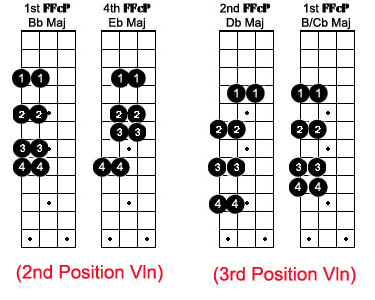
Keep in mind, we're suggesting four FFcP patterns, but you're really only referencing two positions. In other words, you'd start with your 1st finger in the 3rd fret, hold the position through the next FFcP, and you'd move everything up two frets for the next pair (1st finger on the 5th fret).
Here's a chart of how they'd layout during the song:
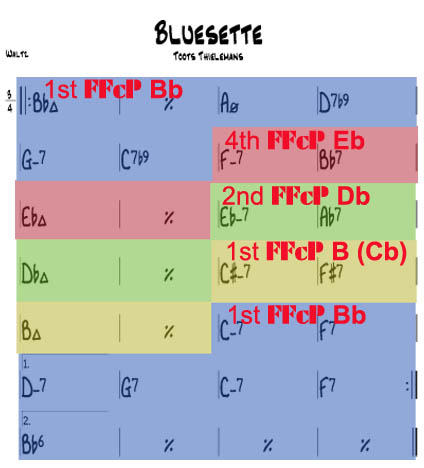
Remember this is a jumping off point. The point is to liberate you from the open positions (1st position) and challenge you up the neck a bit. Eventually you'll want to use more positions, expand up the neck further, and inject chord substitutions. What you'll find though, is once you start taking the training wheel of the bike, you'll be more inclined to ride up the fretboard.
In safety!
Ralph Patt Backing track:  Bluesette Bluesette
Further
Autumn Leaves Pt. 1
Autumn Leaves Pt. 2
Improvisation Techniques
FFcP vs Traditional Violin Positions Fingering
Left hand hover
Posted by Ted at 7:18 AM
 August 2, 2012 | Best of JM: Whole(some) notes
August 2, 2012 | Best of JM: Whole(some) notes
Enjoy the popular archive material below.
From October 8, 2009 | Whole(some) notes"
Plectrum instruments can be at a severe disadvantage competing against bowed or blown instruments. The inability to sustain after the attack, let alone crescendo in volume means we have to dedicate ourselves to not only impeccable articulation and pick precision, but firm, committed finger grip after the stroke.
The majority of players, even some professionals are preoccupied with speed and note velocity when playing, but we maintain if you really want good tone, being able to play with bell-like stamina on long tones is where an alluring sonority starts. When Babe Ruth smacked one out of the park in his baseball glory, it wasn't just about the crack of swamp ash on the stitches, it was where that ball was going to land outside the playing area. We need this sort of mindset in our own playing.
Practicing long, whole-note or half-note tones is a good check-up to how you fare in this ability. Many Folk/Bluegrass musicians cover this weakness with a sustaining motorboat propeller approach to picking, and outside of this genre, it can be at best unsatisfying, and at worst, annoying. The succeeding pick stroke masks this weakness. If you are ever called on to play a set of exposed whole notes in a piece of music, you will quickly regret not mastering this capability.
How do you achieve it? Quite simply, take a scale you are already working on in the lower frets (FFcP would be fine!) and slow the time down fourfold. If you've been playing quarter notes, convert to whole notes, eighth notes to half note. Focus mentally on the pick stroke (especially the downstroke) and the sustain of the fretting fingers, but most crucially, use your ear. Is the resulting sound crystal clear? Does it waiver from a weakening finger? Does it last to your instrument's full potential? This checklist should be employed on EVERY note.

Next, move this up to 3rd and 5th position, playing closed finger scales in the 3rd-9th fret range. Can you get the same sort of clarity? It becomes even harder up the fretboard, as you move to the narrower fret spacings, precision becomes more of a challenge. When you are ready for the next challenge, move it above the 12th fret and project those high octave "pings." Good players can do this, and don't think this just came naturally. They had to work at it, too. They started slow.
We can't stress enough, the importance of this skill in playing the mandolin well.
Put a little "whole-some" in your practice.
Further:
The Crack of the Bat
Forsaking the notes for the music
Starting with good tone
Using the picking hand to start Good Tone.
What makes a jazz mandolin?
Posted by Ted at 7:34 AM

Disclaimer: In the 'Information Age' of the 21st Century,
any fool with a computer, a modem, and an idea can
become a self-professed 'expert." This site does not
come equipped with 'discernment.'
|



